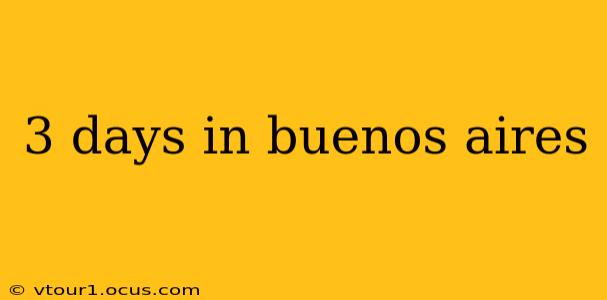Buenos Aires, the "Paris of South America," offers a vibrant tapestry of European elegance and Latin American passion. Three days might seem short, but with careful planning, you can experience its essence. This itinerary balances iconic landmarks with local experiences, ensuring a memorable trip.
Day 1: Exploring the Historic Heart
Begin your Buenos Aires adventure in the heart of the city, exploring the historical districts and embracing the city's rich architectural heritage.
Morning: Plaza de Mayo & Casa Rosada
Start your day at Plaza de Mayo, the city's central square, witnessing the grandeur of the Casa Rosada (Presidential Palace), the Metropolitan Cathedral, and the Cabildo. These landmarks offer a glimpse into Argentina's history and political landscape. Take your time to soak in the atmosphere; you might even catch a protest or street performance—a quintessential Buenos Aires experience.
Afternoon: San Telmo & La Boca
Immerse yourself in the bohemian charm of San Telmo, known for its cobblestone streets, antique shops, and vibrant Sunday market (if your trip coincides). Enjoy a leisurely lunch at a traditional "parrilla" (steakhouse), savoring authentic Argentine cuisine. Afterwards, head to La Boca, a colorful neighborhood famous for its tango culture and Caminito street. Take photos of the brightly painted houses and consider catching a tango show in the evening for an authentic taste of Argentine culture.
Evening: Tango Show
No trip to Buenos Aires is complete without experiencing a tango show. Numerous venues throughout the city offer spectacular performances. Choose one that suits your budget and preferences, from intimate milongas to grand theaters. Many shows incorporate dinner, providing a full sensory experience.
Day 2: Recoleta Elegance & Palermo Soho Chic
Today, explore the contrasting elegance and trendy vibes of different neighborhoods.
Morning: Recoleta Cemetery & Recoleta Neighborhood
Visit the impressive Recoleta Cemetery, the final resting place of Eva Perón and other prominent Argentines. Marvel at the elaborate mausoleums and ornate architecture. Afterwards, explore the upscale Recoleta neighborhood, known for its Parisian-style buildings, elegant boutiques, and charming cafes.
Afternoon: Palermo Soho & Palermo Hollywood
Journey to Palermo Soho, a trendy neighborhood brimming with independent boutiques, art galleries, and stylish cafes. Browse the unique shops, and take a break for coffee and medialunas (crescent rolls). Then, head to Palermo Hollywood, the city's media and entertainment hub. This neighborhood boasts a more relaxed vibe, with cozy bars and restaurants.
Evening: Dinner in Palermo
Palermo offers an extensive array of dining options. From pizza to pasta, traditional Argentine fare to international cuisine, you're sure to find something to your liking. Consider trying a "choripan" (chorizo sandwich) from a street vendor for a casual yet delicious bite.
Day 3: Culture, Parks, & Departure
Your final day offers a blend of culture and relaxation before departure.
Morning: MALBA (Latin American Art Museum)
Begin your day with a dose of culture at the MALBA, featuring a significant collection of Latin American art. Allow ample time to appreciate the masterpieces and learn about the region's artistic heritage.
Afternoon: Bosques de Palermo & Relaxation
Spend your afternoon relaxing in the sprawling Bosques de Palermo, Buenos Aires's largest park. Enjoy a stroll, rent a bike, or simply relax under the shade of the trees. This is a perfect way to unwind before your departure.
Evening: Farewell Dinner & Departure
Enjoy a final Argentinian dinner, savoring the flavors and reflecting on your Buenos Aires experience. Depending on your flight schedule, allow ample time for transportation to the airport.
Frequently Asked Questions (FAQs)
What is the best time to visit Buenos Aires?
The best time to visit Buenos Aires is during the spring (September-November) and autumn (March-May) months, offering pleasant temperatures and fewer crowds than the summer months.
Is Buenos Aires safe for tourists?
Like any major city, Buenos Aires has areas that are safer than others. Exercise common sense, be aware of your surroundings, and avoid walking alone at night in less populated areas.
What is the currency in Buenos Aires?
The currency in Buenos Aires is the Argentinian Peso (ARS). Credit cards are widely accepted, but it's advisable to have some local currency on hand for smaller purchases.
What language is spoken in Buenos Aires?
The official language of Buenos Aires is Spanish. While some locals speak English, learning a few basic Spanish phrases will enhance your experience.
How much does a trip to Buenos Aires cost?
The cost of a trip to Buenos Aires varies depending on your travel style and preferences. You can find budget-friendly options, as well as luxurious accommodations and dining experiences. Research and plan accordingly to fit your budget.
This itinerary serves as a starting point for your Buenos Aires adventure. Feel free to tailor it to your interests and preferences, ensuring an unforgettable trip to this captivating city. Remember to embrace the vibrant culture, savor the delicious food, and lose yourself in the rhythm of the tango.
